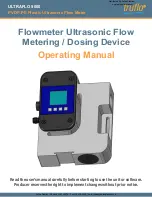
3
SECTION I: INTRODUCTION
The GA-92XTd magnetic locator detects the magnetic field of ferromagnetic objects. It
responds to the difference in the magnetic field between two sensors that are spaced
approximately 9.5 inches apart. This difference is referred to as the “signal strength”
throughout this manual and is represented in the instrument by an audio tone, the display of a
bar graph, and a numeric indication. In addition, the polarity of the signal strength is shown
as a + or – sign on the display, and determines the side (right or left) on which the bar graph
is displayed. Although most objects can be located using the audio indication alone,
simultaneous use of the audio and visual responses will provide additional information to help
you pinpoint a target and determine its orientation.
Figure 1 illustrates an application of the GA-92XTd locator in which it is used to detect an iron
marker used for property line identification. As shown, the magnetic field of the iron marker is
stronger at sensor A than it is at sensor B. This creates a signal strength that is larger than
zero (which would occur when the field strength is the same at both sensors).
The audio response of the GA-92XTd is designed so that the frequency of the audio tone
increases as the detected signal strength increases. As a result, the frequency of the audio
output is higher than the idling frequency (~ 30 Hz) that exists when the signal strength is
approximately zero. The larger signal strength also causes the bar graph display to peak in
either the positive or the negative direction.
Figure 1: Detecting Magnetic Field of an Iron Marker




































